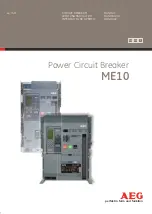
IB 6.1.12.1-1C
1
1
ABB
CIRCUIT BREAKER OPERATION
In principle, all K-Line circuit breakers cycle through
three stages of operation: charging, closing, and
opening. The charging and closing stages differ
between MO and EO mechanisms in that a MO
mechanism does not intermediately store charged
closing spring energy.
Racking
Draw-out breakers are racked between positions of
DISCONNECTED, TEST, and CONNECTED.
Reference the decal either on the escutcheon box
right-side (door closed) or on the left cradle arm (door
open). Using the decal as a reference, the breaker is
properly in position when the racking shutter closes
after handle removal.
Within the breaker, an index cam interlocks the
racking mechanism with the breaker contact position.
The shutter prohibits racking handle access to the
drive input until the breaker is opened. Additionally,
the shutter must fully close in each position, because
the interlocking places the mechanism trip-free
between draw-out positions. For EO breakers,
attempted closure will discharge the charged closing
springs without driving the breaker mechanism. With
MO breakers, the closing handle will not even engage
the closing springs. The interlocking prevents
connecting or disconnecting a closed breaker with an
energized circuit.
Placing a draw-out breaker into service:
1. Open the breaker.
2. With the breaker mounted on extended rails, turn
the racking handle fully CCW (counter-clockwise).
Push the breaker into the cubicle. The draw-out
arm roller on both sides of the breaker engages
with the track of the cradle.
3. Turn the racking handle CW (clockwise); placing
the breaker into the TEST position. Make pre-
operative checks.
4. Completely turn the handle CW until the racking
mechanism stops, placing the breaker in the
CONNECTED position. A momentary resistance
to motion will be noticed as the spring-loaded
disconnects engage the cubicle stabs.
Removing a draw-out breaker from service:
1. Place the motor disconnect switch (if equipped) in
the OFF position to prevent subsequent closing
spring recharging after breaker opening. Open the
breaker.
2. Rotate the handle CCW, placing the breaker in
the TEST position.
3. Rack fully CCW into the DISCONNECTED
position. If the closing springs are charged, the
automatic spring discharge feature will discharge
the charged closing springs within the last few
turns of the handle.
Charging Operation
The potential energy of charged closing springs close
the circuit breaker contacts. Electrically operated
mechanisms store spring energy until triggered to
close. Manually operated breakers both charge and
close in one sequence.
Electrically Operated Mechanism
The charging motor charges the closing springs.
Under a normal wiring configuration as illustrated in
Figure A1 of Appendix A, the motor will charge the
closing springs of an open breaker having control
power, unless the MDS is positioned OFF. The closing
springs discharge in the process of closing the circuit
breaker. Upon closing, the L/b contact at terminals 1
and 2 opens, preventing power to the motor through
the closed LS/1 charging spring limit switch. Upon
opening, the L/b contact closes and the breaker
immediately recharges its closing springs for re-
closure. Some charging circuits are configured without
the auxiliary switch contact L/b at terminals 1 and 2, in
which case the charging springs immediately recharge
after closing the circuit breaker. An anti-pump relay
within the control relay device prevents repetitive
breaker closure if a close input is maintained during a
trip-free condition.
CAUTION
Do not forget to leave the motor disconnect switch ON after
maintenance, else the breaker cannot be charged electrically
for subsequent closure.
Use the Maintenance Handle accessory to manually
charge the closing springs when control power for the
Figure 2. Maintenance Handle Engagement.





































